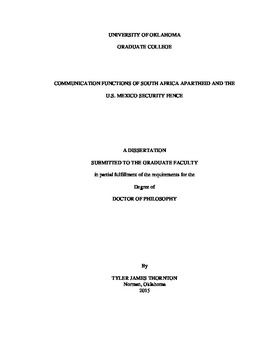| dc.contributor.advisor | Kramer, Eric Mark | |
| dc.contributor.author | Thornton, Tyler J. | |
| dc.date.accessioned | 2015-04-21T19:51:07Z | |
| dc.date.available | 2015-04-21T19:51:07Z | |
| dc.date.issued | 2015 | |
| dc.identifier.uri | https://hdl.handle.net/11244/14439 | |
| dc.description.abstract | Powerful semiotic signs like the Great Wall of China and the Berlin Wall served significant communicative functions. The modern culture of nation state wall building continues despite the fact that the security fences are obsolete. Wall advocates argue that security fences deter undocumented immigrants from trying to cross the border illegally. The walls also function to stop terrorism or other criminal threats. This paper applies semiotic and hermeneutic methods to examine and compare the communication functions of South African apartheid with the U.S. Mexico border wall. Structuration Theory (ST),and Dissociation and Dimensional Accrual (DAD) are applied to discuss the consequences to communication from such barriers. | en_US |
| dc.language | en_US | en_US |
| dc.subject | Structuration Theory | en_US |
| dc.subject | Dissociation and Dimensional Accrual (DAD) | en_US |
| dc.subject | Borderlands | en_US |
| dc.subject | Walls and Fences | en_US |
| dc.title | COMMUNICATION FUNCTIONS OF SOUTH AFRICA APARTHEID AND THE U.S. MEXICO SECURITY FENCE | en_US |
| dc.contributor.committeeMember | O'Neill, Sean | |
| dc.contributor.committeeMember | Rodriguez, Clemencia | |
| dc.contributor.committeeMember | Hsieh, Elaine | |
| dc.contributor.committeeMember | Reedy, Justin | |
| dc.date.manuscript | 2015 | |
| dc.thesis.degree | Ph.D. | en_US |
| ou.group | College of Arts and Sciences::Department of Communication | en_US |
